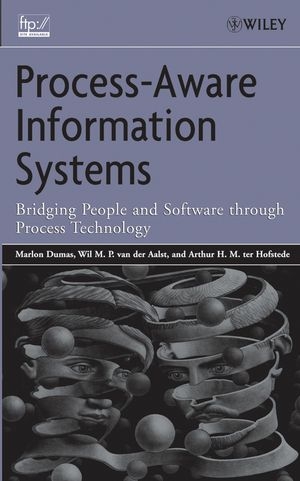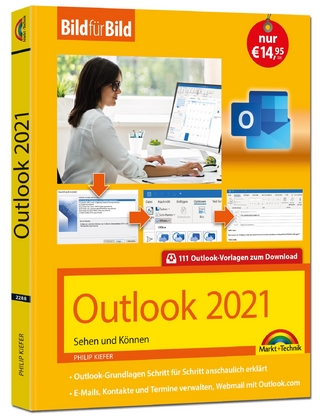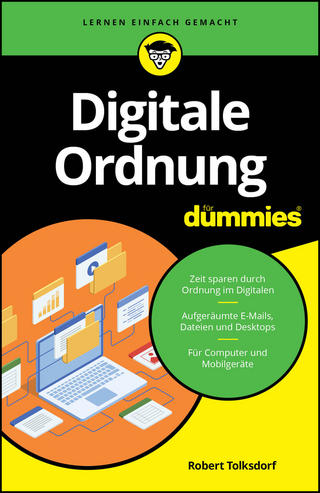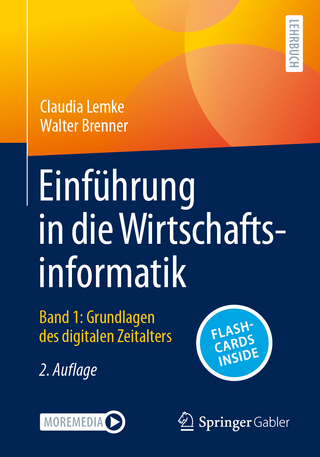
Process-Aware Information Systems
Wiley-Interscience (Verlag)
978-0-471-66306-5 (ISBN)
A unifying foundation to design and implement process-aware information systems
This publication takes on the formidable task of establishing a unifying foundation and set of common underlying principles to effectively model, design, and implement process-aware information systems. Authored by leading authorities and pioneers in the field, Process-Aware Information Systems helps readers gain a thorough understanding of major concepts, languages, and techniques for building process-aware applications, including:
* UML and EPCs: two of the most widely used notations for business process modeling
* Concrete techniques for process design and analysis
* Process execution standards: WfMC and BPEL
* Representative commercial tools: ARIS, TIBCO Staffware, and FLOWer
Each chapter begins with a description of the problem domain and then progressively unveils relevant concepts and techniques. Examples and illustrations are used extensively to clarify and simplify complex material. Each chapter ends with a set of exercises, ranging from simple questions to thought-provoking assignments. Sample solutions for many of the exercises are available on the companion Web site.
Armed with a new and deeper understanding, readers are better positioned to make their own contributions to the field and evaluate various approaches to a particular task or problem. This publication is recommended as a textbook for graduate and advanced undergraduate students in computer science and information systems, as well as for professionals involved in workflow and business process management, groupware and teamwork, enterprise application integration, and business-to-business integration.
A Solution's Manual is available online. An Instructor Support FTP site is also available.
MARLON DUMAS, PhD, is a Senior Lecturer at Queensland University of Technology. Dr. Dumas has published extensively in international journals and conferences in the areas of business process management and service-oriented computing, and is the recipient of a Smart State Fellowship from the Queensland Government. WIL M. P. van der AALST, PhD, is Professor at Eindhoven University of Technology and Adjunct Professor at Queensland University of Technology. He is coauthor of the textbook Workflow Management: Models, Methods, and Systems, and editor of several other books in the areas of business process management and Petri nets. ARTHUR H. M. ter HOFSTEDE, PhD, is Associate Professor at Queensland University of Technology. He, along with Professor van der Aalst, is codesigner of the YAWL workflow language and open-source system, coauthor of the Workflow Patterns Web site, and cofounder of the International Conference on Business Process Management.
Preface. Contributors.
PART I Concepts.
1 Introduction (Marlon Dumas, Wil van der Aalst, and Arthur H. M. ter Hofstede).
1.1 From Programs and Data to Processes.
1.2 PAIS: Definition and Rationale.
1.3 Techniques and Tools.
1.4 Classifications.
1.5 About the Book.
References.
2 Person-to-Application Processes: Workflow Management (Andreas Oberweis).
2.1 Introduction.
2.2 Workflow Terminology.
2.3 Workflow Modeling.
2.4 Workflow Management Systems.
2.5 Outlook.
2.6 Exercises.
References.
3 Person-to-Person Processes: Computer-Supported Collaborative Work (Clarence A. Ellis, Paulo Barthelmess, Jun Chen, and Jacques Wainer).
3.1 Introduction.
3.2 Characterization of Person-to-Person Interactions.
3.3 Characterization of Person-to-Person Systems.
3.4 Example Systems.
3.5 Summary and Conclusions.
3.6 Exercises.
References.
4 Enterprise Application Integration and Business-to-Business Integration Processes (Christoph Bussler).
4.1 Introduction.
4.2 Examples of EAI and B2B Processes.
4.3 Concepts, Architectures, and Tools.
4.4 Future Developments.
4.5 Exercises.
References.
PART II Modeling Languages.
5 Process Modeling Using UML (Gregor Engels, Alexander Förster, Reiko Heckel, and Sebastian Thöne).
5.1 Introduction.
5.2 Modeling Control Flow with Activity Diagrams.
5.3 Modeling Objects and Object Flow.
5.4 Modeling Organizational Structure.
5.5 Modeling Business Partner Interactions.
5.6 System-Specific Process Models.
5.7 Summary.
5.8 Exercises.
References.
6 Process Modeling Using Event-Driven Process Chains (August-Wilhelm Scheer, Oliver Thomas, and Otmar Adam).
6.1 Introduction.
6.2 Overview of EPC.
6.3 The ARIS Business Process Meta-Model.
6.4 How to Correctly Model EPCs.
6.5 The ARIS Architecture.
6.6 Future Extensions.
6.7 Exercises.
References.
7 Process Modeling Using Petri Nets (Jörg Desel).
7.1 Introduction.
7.2 Petri Nets.
7.3 Petri Net Classes and Behavior.
7.4 Modeling Single Processes Without Resources.
7.5 Modeling Processes with Resources.
7.6 Behavior and Refinement.
7.7 Analysis.
7.8 Net Classes.
Exercises.
References.
8 Patterns of Process Modeling (Wil van der Aalst, Arthur H. M. ter Hofstede, and Marlon Dumas).
8.1 Introduction.
8.2 Classification of Patterns.
8.3 Examples of Control-Flow Patterns.
8.4 Conclusion.
8.5 Exercises.
Acknowledgments.
References.
PART III Techniques.
9 Process Design and Redesign (Hajo A. Reijers).
9.1 Introduction.
9.2 Methodologies, Techniques, and Tools.
9.3 Business Process Performance Indicators.
9.4 Redesigning Processes Using Best Practices.
9.5 Information-Based Business Process Design.
9.6 Conclusion.
9.7 Exercises.
References.
10 Process Mining (Wil van der Aalst and A.J.M.M. (Ton) Weijters).
10.1 Introduction.
10.2 Process Mining: An Overview.
10.3 Process Mining with the Algorithm.
10.4 Limitations of the Alpha Approach and Possible Solutions.
10.5 Conclusion.
10.6 Exercises.
Acknowledgments.
References.
11 Transactional Business Processes (Gustavo Alonso).
11.1 Introduction.
11.2 Transactional Consistency.
11.3 Atomicity.
11.4 Infrastructure for Implementing Atomicity.
11.5 Outlook.
11.6 Exercises and Assignments.
Acknowledgments.
References.
PART IV Standards and Tools.
12 Standards for Workflow Definition and Execution (Jan Mendling, Michael zur Muehlen, and Adrian Price).
12.1 Introduction.
12.2 Standardization Bodies Relevant to PAIS.
12.3 WfMC Reference Model and WfMC Glossary.
12.4 Process Definition in XPDL.
12.5 Process Invocation Using WF-XML.
12.6 Trends.
12.7 Exercises.
References.
13 The Business Process Execution Language for Web Services (Rania Khalaf, Nirmal Mukhi, Francisco Curbera, and Sanjiva Weerawarana).
13.1 Introduction to Web Services.
13.2 BPEL4WS.
13.3 Summary.
13.4 Exercises.
References.
14 Workflow Management in Staffware (Charles Brown).
14.1 Introduction.
14.2 Architecture.
14.3 Integration Tools.
14.4 Methodology.
14.5 Resourcing.
14.6 Conclusion.
14.7 Exercises.
References.
15 The FLOWer Case-Handling Approach: Beyond Workflow Management (Paul Berens).
15.1 Outline.
15.2 Overview of Case Handling and FLOWer.
15.3 Conceptual Integrity of FLOWer.
15.4 Golden Rules of Process Management.
15.5 Conclusion.
Acknkowledgment.
References.
Appendix: Readings and Resources.
Index.
| Erscheint lt. Verlag | 21.10.2005 |
|---|---|
| Reihe/Serie | Wiley-Interscience |
| Zusatzinfo | Drawings: 50 B&W, 0 Color |
| Sprache | englisch |
| Maße | 162 x 238 mm |
| Gewicht | 710 g |
| Themenwelt | Informatik ► Office Programme ► Outlook |
| Technik ► Elektrotechnik / Energietechnik | |
| ISBN-10 | 0-471-66306-9 / 0471663069 |
| ISBN-13 | 978-0-471-66306-5 / 9780471663065 |
| Zustand | Neuware |
| Haben Sie eine Frage zum Produkt? |
aus dem Bereich


